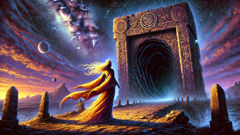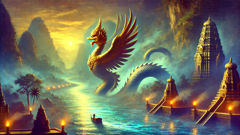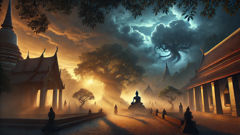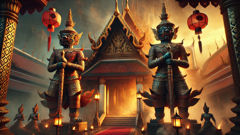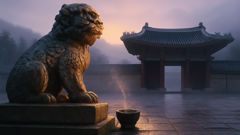Introduction
In the cradle of civilization, where the Tigris and Euphrates rivers wound their way through the fertile heart of Mesopotamia, the city-states hummed with the daily rhythm of life and devotion. People prayed in ziggurats rising like stairways to the gods, and clay tablets whispered the stories of deities who shaped fate and nature alike. Among these divine beings, none shone brighter than Inanna—the goddess of love, war, fertility, and the star-strewn sky. Her presence was felt in the lush fields, in the bustling bazaars, and in the passionate hearts of mortals. Yet even the mighty Inanna harbored longing for power beyond her dominion, a hunger that reached deep beneath the sunlit world. She gazed upon the netherworld, where her sister Ereshkigal reigned as Queen, draped in shadows and sorrow. It was a realm where no living soul returned unchanged, a world ruled by the inexorable laws of death and silence. The path between these sisters was fraught with ancient rivalry and mysteries as old as the Sumerian soil. Driven by both destiny and curiosity, Inanna resolved to descend into the Underworld—risking all she possessed and all she was. Her descent would become a tale whispered through millennia, a myth carved into stone and spirit alike. As Inanna prepared for her journey, the gods watched, mortals trembled, and the boundaries between life and death wavered in the desert wind.
The Calling: Inanna’s Decision and Preparation
The city of Uruk pulsed with life, its walls sheltering merchants, scribes, and priests who offered incense to the gods at every sunrise. Inanna’s temple, resplendent with silver and lapis lazuli, was the heart of devotion and celebration. Yet within its sacred chambers, Inanna herself felt a restlessness—a yearning that not even adoration or earthly riches could quiet. The Queen of Heaven was haunted by dreams: visions of a land where dust covered all and the air was thick with the sighs of the dead. At the center of these dreams stood her sister, Ereshkigal, stern and sorrowful, crowned by darkness. Night after night, Inanna awoke with a sense of unfinished destiny.
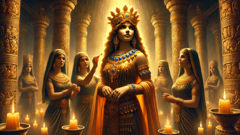
Restless, Inanna strode through her temple’s echoing halls, her footsteps silent on polished stone. She sought counsel from her faithful servant and confidant, Ninshubur, whose wisdom was renowned among gods and mortals alike. “My heart leads me downward,” Inanna confessed, voice trembling with both excitement and fear. “I must visit the realm of Ereshkigal. There is power there I do not know—knowledge and shadow intertwined.”
Ninshubur’s eyes widened with concern, understanding all too well the dangers awaiting any who entered the Underworld. “Great Lady, the netherworld is not for the living. You may not return. Should you fail to ascend, who will sing your name among the stars?”
But Inanna’s resolve burned brighter than ever. She prepared herself in ritual fashion, donning her seven sacred adornments: the royal crown of steppe, symbol of her sovereignty; the measuring rod and line, tools of judgment and command; a heavy necklace of shimmering lapis; twin bracelets gleaming with gold; a breastplate that sparkled with gemstones; a layered robe of purest white; and the golden ring of authority upon her wrist. Each piece held ancient power, woven from divinity and legend.
Before departing, Inanna entrusted Ninshubur with instructions. “If I do not return after three days and nights, go to the gods. Plead for my life before Enlil, Nanna, and Enki. Do not let my light be lost beneath the earth.”
As dawn blushed over Uruk, Inanna left her temple, her regalia shining in the early light. Citizens watched in awe, sensing that something profound was afoot. She walked past silent fields and bustling streets, toward the place where the living world thins and the boundary to the Underworld shimmers like a mirage. The air grew chill, and even the birds fell silent as Inanna approached the first of the seven gates.
It was said that the gates to the Underworld lay beneath the roots of the world tree, huluppu, whose branches touched the sky and whose roots delved into mysteries untold. There, Inanna paused for a final breath of warm air. The journey had begun.
The Seven Gates: Trials and Sacrifice
The descent began at the threshold to Kur—the great Underworld of Mesopotamian myth. The first gate loomed before Inanna, guarded by Neti, the chief gatekeeper, whose eyes were as old as time and whose hands held the power to admit or deny all souls. Neti’s voice, rough as gravel, echoed in the silence: “Who seeks entrance to the realm of Ereshkigal?”
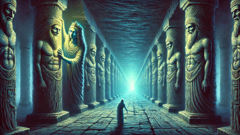
Inanna answered with regal confidence, naming herself as Queen of Heaven and Earth, come to pay respects to her sister. Neti, bound by the laws of Kur, could not refuse, but he sent word ahead to Ereshkigal. The message—like a cold wind—swept through the Underworld: “Your sister stands at your gate.”
Ereshkigal was troubled. She knew well the ambitions of her radiant sister. Nevertheless, she instructed Neti: “Let her enter. But at each gate, strip away one of her adornments.” And so, the ordeal began.
At the first gate, Inanna surrendered her crown. The symbol of her rule was taken, leaving her hair uncovered for the first time since childhood. At the second gate, the measuring rod and line—her tools of judgment—were stripped away. With each gate, Neti demanded another sacred possession: her sparkling necklace at the third, her bracelets at the fourth, her breastplate at the fifth, her flowing robe at the sixth, and finally, at the seventh gate, her golden ring.
By the time Inanna passed through the last gate, she was naked as a newborn—stripped not only of garments but of power, pride, and protection. She stood vulnerable before Ereshkigal’s black throne, surrounded by silent judges of the dead. The contrast between sisters was stark: Inanna, pale and unadorned, yet radiant in her defiance; Ereshkigal, cloaked in darkness, her face inscrutable beneath a veil.
Ereshkigal did not rise to greet her sister. Instead, she pronounced judgment, unleashing the Annuna—spirits of the Underworld—upon Inanna. These seven judges fixed her with the gaze of death. Inanna’s life force was drained; she was transformed into a lifeless husk and hung upon a hook like a slab of meat. All light from her eyes faded, and in that moment, the upper world felt her absence. Crops withered, lovers mourned, and temples fell silent. Ninshubur, true to her promise, went to plead for Inanna’s release.
Ninshubur’s journey was fraught with desperation and loyalty. She fell at the feet of Enlil, god of air and king of the gods, but he turned away: “The ways of the Underworld are sacred. None may interfere.” Next she sought Nanna, god of the moon and Inanna’s father. But even he would not risk upsetting the balance. Only Enki, god of wisdom and water, offered help—crafting two tiny beings from the dirt beneath his fingernails: the kurgarra and galatur. He instructed them to slip unnoticed into Kur and offer empathy to Ereshkigal in her pain.
As Inanna hung in darkness, Ereshkigal writhed in agony, tormented by pangs no one could soothe. When the kurgarra and galatur arrived, they did not try to heal her pain but echoed it—mourning alongside her. Moved by their understanding, Ereshkigal offered them a boon. They asked for Inanna’s lifeless body. Bound by her promise, Ereshkigal released it. The tiny beings sprinkled Inanna with the food and water of life, restoring her spirit.
Return and Renewal: Inanna’s Resurrection and Legacy
Revived but still weak, Inanna prepared to ascend. Yet the Underworld did not let go so easily. The Annuna seized her—no one could leave Kur without sending a substitute in their place. By sacred law, someone must remain among the dead.
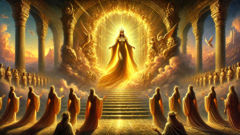
Inanna ascended through the gates in reverse order, regaining her adornments one by one. With each piece reclaimed, she grew stronger and more luminous, yet her heart was heavy with the burden of the Underworld’s demand. Who would take her place? She thought of Ninshubur, her faithful friend who had saved her, and refused to offer her as sacrifice. She thought of her children and loyal servants—none deserved such a fate.
At last, Inanna returned to Uruk. The city rejoiced; crops greened and music filled the air once more. Yet peace was fleeting. Inanna discovered that while she was gone, her husband Dumuzi had not mourned but celebrated, seated on her throne in rich garments. Anger surged within her. If any must go in her place, it would be Dumuzi. The Annuna descended upon him, binding his hands. Dumuzi pleaded, and his sister Geshtinanna volunteered to share his fate. Thus began the cycle: half the year Dumuzi would dwell below, half above—a mythic explanation for seasons and rebirth.
Inanna’s ordeal left an indelible mark on both divine and mortal realms. Her courage had torn open the boundaries between life and death. She returned with knowledge deeper than any goddess before her: that power is won through sacrifice, that empathy can heal even those lost in shadow, and that every ending is a prelude to renewal. Inanna’s descent and return echoed through the fields with every harvest and every drought. She became not just the Queen of Heaven but also a bridge between worlds—a symbol of hope for all who must endure darkness to find the dawn.
Conclusion
The descent of Inanna is a tale carved in clay and memory—a myth that endures because it speaks to what lies at the heart of all human journeys: loss, endurance, transformation, and hope. Through each of the seven gates, Inanna left behind pride and power, emerging not diminished but remade by her willingness to confront the unknown. Her passage through death’s domain brought renewal to herself and the world above. The Mesopotamians saw in her myth not only an explanation for changing seasons but also a guide for surviving life’s hardest passages. Inanna’s courage to descend, her resilience through trials, and her compassion upon return remain as relevant today as in ancient times. Each generation finds meaning in her story—a reminder that even when we feel stripped bare by fate or circumstance, there is a path back to light and life. The goddess who dared to enter the darkness shows that rebirth is always possible for those who persevere.

